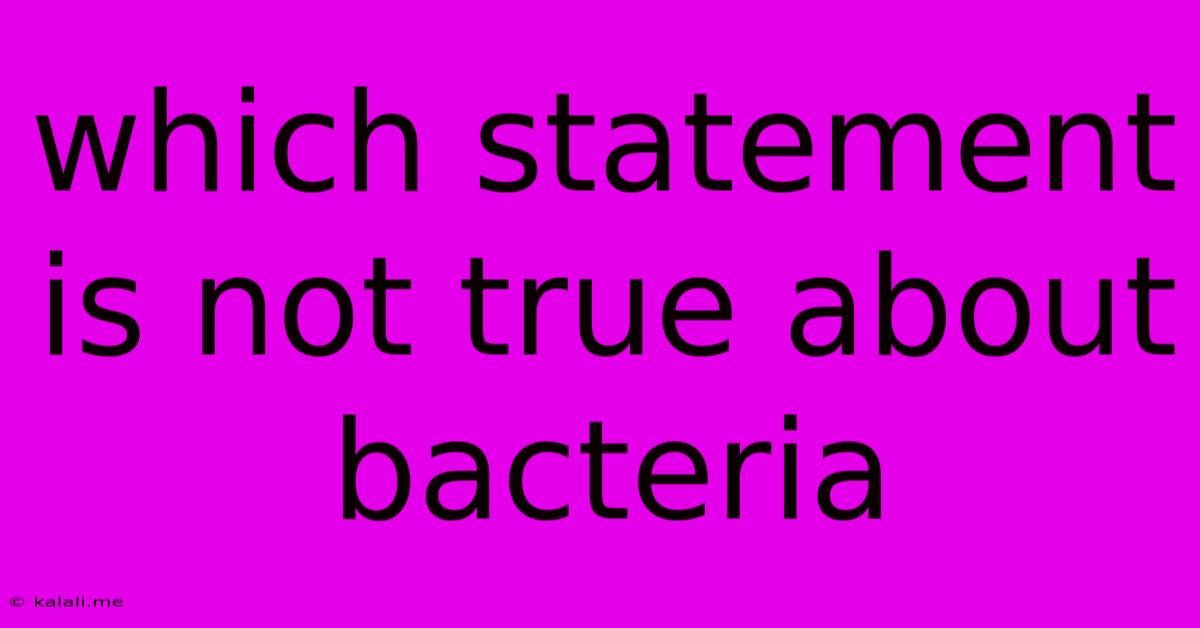Which Statement Is Not True About Bacteria
Kalali
Jun 12, 2025 · 3 min read

Table of Contents
Which Statement is Not True About Bacteria? Debunking Common Misconceptions
Bacteria are microscopic, single-celled organisms that are ubiquitous in our environment. They play crucial roles in various ecosystems, from decomposing organic matter to aiding digestion in animals. However, many misconceptions surround these tiny powerhouses. This article will explore some common statements about bacteria and identify which one is not accurate. We'll delve into the fascinating world of bacteriology, examining their structure, function, and impact on our lives.
Understanding Bacterial Characteristics: Before we tackle the false statement, let's refresh our understanding of bacterial characteristics. Bacteria are prokaryotes, meaning they lack a membrane-bound nucleus and other membrane-bound organelles found in eukaryotes (like plants and animals). They reproduce asexually through binary fission, a relatively rapid process. Their genetic material, a single circular chromosome, is located in the cytoplasm. Bacteria possess a cell wall, which provides structural support and protection. They also exhibit incredible diversity in terms of metabolism, habitat, and pathogenic potential. Some are beneficial, playing vital roles in nutrient cycling and human health, while others are harmful, causing diseases.
Common Statements About Bacteria: Let's examine some commonly held beliefs about bacteria:
-
Statement 1: All bacteria are harmful. This is false. The vast majority of bacteria are harmless and even beneficial to humans and the environment. Many bacteria contribute to nutrient cycling, decomposition, and even aid in digestion within our gut. They're essential for the health of various ecosystems.
-
Statement 2: Bacteria are always visible to the naked eye. This is false. Bacteria are microscopic organisms and can only be seen with the aid of a microscope. Their size typically ranges from 0.5 to 5 micrometers.
-
Statement 3: Bacteria reproduce sexually. This is false. Bacteria primarily reproduce asexually through binary fission, where a single cell divides into two identical daughter cells. While horizontal gene transfer mechanisms like conjugation, transformation, and transduction exist, these are not considered sexual reproduction in the classical sense.
-
Statement 4: Bacteria lack a cell wall. This is false. Most bacteria possess a cell wall, a rigid outer layer that provides structural support and protection. The composition of the bacterial cell wall (peptidoglycan in most cases) is a key characteristic used in bacterial classification and identification. Exceptions exist, such as Mycoplasma species, which lack a cell wall.
-
Statement 5: Bacteria are only found in soil and water. This is false. While bacteria are abundant in soil and water environments, they are found virtually everywhere – in the air, on our skin, in our digestive tracts, and even in extreme environments like deep-sea hydrothermal vents. Their adaptability is remarkable.
Identifying the Inaccurate Statement: Several of the above statements are false, highlighting the common misconceptions surrounding these organisms. However, the statement that is most definitively and broadly incorrect is Statement 1: All bacteria are harmful. The vast majority of bacteria are not harmful, and many are essential for life as we know it. While pathogenic bacteria cause disease, it's crucial to remember that this represents only a small fraction of the total bacterial diversity.
Conclusion: Understanding bacteria is crucial for appreciating their multifaceted roles in our world. By dispelling common misconceptions, we can foster a more accurate and nuanced understanding of these essential microorganisms. Their importance in various ecological processes and their potential applications in biotechnology continue to be subjects of ongoing research and discovery.
Latest Posts
Latest Posts
-
Which Of The Following Is An Example Of Positive Punishment
Jun 13, 2025
-
What Type Of Consumer Are Humans
Jun 13, 2025
-
The Unit Of Resistance Is The
Jun 13, 2025
-
Which Of The Following Is Not A Characteristic Of Minerals
Jun 13, 2025
-
The Unit Of Capacitance Is The
Jun 13, 2025
Related Post
Thank you for visiting our website which covers about Which Statement Is Not True About Bacteria . We hope the information provided has been useful to you. Feel free to contact us if you have any questions or need further assistance. See you next time and don't miss to bookmark.